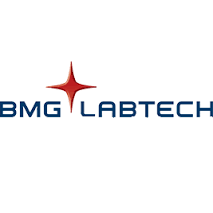Introduction
Calcium is a common second messenger released upon stimulation of different G-protein coupled receptors (GPCRs). Measuring intracellular calcium is therefore a widely applicable method for functional screening of compounds for various GPCRs. Herein, we describe a fast and sensitive method to sequentially screen compounds for agonism or antagonism. The human dopamine D1 and D2L receptors (Gs/Gi/q coupled) were recombinantly expressed in HEK293 cells and were screened using the NOVOstar fl uorescence microplate reader from BMG LABTECH, Offenburg, Germany.
Calcium Measurements
One T75 fl ask of HEK293 cells (~90% confl uent) expressing the GPCR of interest was harvested using trypsin/EDTA and was rinsed with culture medium containing 10% fetal bovine serum, 50 µg/mL streptomycin, 50 U/mL penicillin and 365 µg/mL L-glutamine. Pelleted cells were then resuspended in fresh medium. They were kept under 5% CO2 at 37°C for 1 h while being vortexed every 15 min. Then, after two washes with Krebs-HEPES buffer (118 mM NaCl, 4.7 mM KCl, 1.2 mM MgSO4, 1.2 mM KH2PO4, 4.2 mM NaHCO3, 11.7 mM D-glucose, 1.3 mM CaCl2, 10 mM HEPES, pH 7.4) cells were loaded with 3 µM Oregon Green 488 BAPTA-1/AM (Molecular Probes, Eugene, OR, USA) for 1 h in Krebs-HEPES buffer containing 1% (wt/vol) Pluronic F-127. Then, cells were rinsed three times with Krebs-HEPES buffer containing 0.5% (wt/vol) bovine serum albumin (BSA), diluted and evenly plated into a quadrant of a 384-well plate (black plate, clear bottom, cat. no.: 781091, Greiner Labortechnik GmbH, Frickenhausen, Germany) at a concentration of ~12,000 cells/well. The volume of cell suspension added to each well is 64 µL. After 15 min, 8 µL of Krebs-HEPES buffer alone or increasing concentrations of test compounds dissolved in buffer were injected from the 384-well-reagent-plate into the corresponding wells of the 384-well-measurement-plate containing the cell suspension; fl uorescence intensity is monitored for 30 s (Fig. 1). Subsequently, a second run was started to screen the test compounds (injected in the fi rst run) for antagonistic activity. Test compounds were incubated for 30-60 min. Screening for antagonistic activity was performed by injection of 8 µL of a standard agonist (concentration: 5x EC50) into each well of the 384-well-measurementplate by using the NOVOstar pipetting system and one of the reagent stations. SKF38393 was used as agonist for hD1 receptors. Quantitative data (EC50 or IC50 values) are obtained as follows: the maximum fl uorescence intensity of each data set is determined, and concentration-response curves of agonists or antagonists are constructed by nonlinear regression curve fi tting using a four parameter logistic equation on Prism 3.0.
Materials All chemicals
were obtained from Sigma Chemical, Taufkirchen, Germany, unless otherwise stated.
Measurement Parameters
Measurement plate: Greiner 384
Reagent plate: Greiner 384
Measurement mode: Fluorescence
Test type: Well mode
Excitation fi lter: 485 nm
Emission fi lter: 520 nm
Temperature: 37°C
No. of fl ashes: 10
Positioning delay: 0.5 s
Air volume to aspirate: 10 µL
Air volume to dispense: 10 µL
Number of kinetic windows: 2
Number of intervals: 40 – 55
Start measurement: 0.0 s
Measurement interval time: 0.40 s
Pipettor source: Reagent plate (injection of test compound)
Reagent pos. 2 (injection of standard agonist)
Injection speed: 50 µL/s
Injection time: 7.0 – 8.0 s
Aspirate depth: 9.5 mm (injection of test compound, reagent plate) 30.0 mm (injection of standard agonist, reagent pos.
2) Dispense depth: 6.0 mm
Needle rinse cycles: 1 (when injection of test compound) (between injections) 3 (when injection of standard agonist)
The applicability of the calcium assay was also shown for recombinant mu- and delta-opioid receptors (Gi coupled) in HEK293 cells, as well as wildtype and recombinant muscarinic acetylcholine M1 receptors (Gq/11 coupled) in HEK293 or CHO cells (data not shown).
Text taken from www.bmglabtech.com

